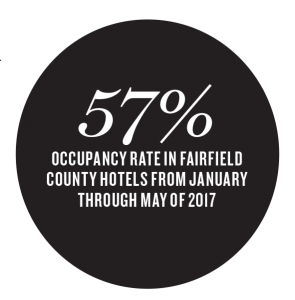Trending
Hotels go small
As business travel lags, boutique hotels find niche

On any given night in Fairfield County, about four in 10 hotel rooms remain vacant. The occupancy rate in this tony corner of Connecticut is significantly lower than the national average. But even as vacancies climb and revenues dip, local hoteliers and government officials say the future for the county’s hotel industry could be bright, so long as it is willing to change with the times.
Some of the issues facing the market are part of a national trend. “Less is being spent on actual traveling from the business traveler side these days,” said Lisa Mercurio, a vice president at the Business Council of Fairfield County.
That’s a significant hurdle for an area of the country best known for its white-collar workforce. And while Fairfield County and the rest of the country have mostly bounced back from the Great Recession, “business travel isn’t necessarily back to the same level it was before the recession,” said JoAnn Cueva, director of the Greater Danbury Chamber of Commerce.
“Budgets have been cut, and as a result, travel is certainly part of what has been cut,” she said. “So there’s more teleconferencing, and people are taking on more responsibilities as their job roles expand. Because of this, the travel is not up to the same level it was.”
This has hit big chains particularly hard. So has a change in demographics.
“We’ve had a mini-resurgence, if you will, in our downtown Danbury area recently. And what we’re seeing is the primary group coming in is a younger demographic,” said Cueva. “Because of that, there have been new businesses that have popped up. New restaurants, apparel and retail shops right downtown.”
 It’s changed the city’s appeal, turning a bedroom community into a lively spot for millennials as the share of residents between the ages of 20 and 34 climbed to 22.4 percent of Danbury’s population — higher than the national average, according to the most recent figures from the U.S. Census Bureau.
It’s changed the city’s appeal, turning a bedroom community into a lively spot for millennials as the share of residents between the ages of 20 and 34 climbed to 22.4 percent of Danbury’s population — higher than the national average, according to the most recent figures from the U.S. Census Bureau.
This influx of young adults has proven to be beneficial for boutique hotels.
The J House hotel in Greenwich opened six years ago and underwent a major renovation in 2015, changing out staff spaces for a new, high-end spa and adding other top-shelf amenities as it competes with the castle-like Hyatt Regency Greenwich just down the street.
It’s been able to set itself apart from the more buttoned-up offerings around the county by becoming a late-night hot spot for cocktails and fine dining.
In 2009, Stamford-based developer RMS Companies opened Hotel Zero Degrees, just behind the bars that line Stamford’s trendy Main Street. Surrounded by nightlife and restaurants, the downtown hotel was a hit, and in 2013, RMS opened a second location in Norwalk.
The Norwalk edition was closer to corporations than to watering holes, but a rooftop deck and proximity to the train line into Manhattan continued to bolster the success of the new location, said Nicole Caruso, a spokesperson for RMS.
So last fall, RMS opened a third location, this time in Danbury. “From a social perspective, it’s got modern design, and absolutely, it’s a draw for the younger crowd,” Caruso said.
Its opening marked the first increase in the county’s supply in years, according to Jan Freitag, senior vice president of lodging insights at STR. But with such low demand for rooms, its appearance wasn’t exactly a boon to the area’s hotel market. Year-to-date occupancy rates in Fairfield County were hovering at 57.3 percent as of May.
Revenue per available room is down 5.9 percent from last year, to $70.59, STR said. Room rates have a county average of $123 per night, just under the national average of $125, STR reported.
“They’re probably saying, ‘Hey, what can I do against occupancy slipping? I probably won’t increase my room rates as much, maybe I’ll discount a bit,’” Freitag says.
In addition to discounts, there’s one other place hotels are turning to pad their losses: dining.
At Hotel Zero Degrees, there’s been a concerted effort to make the hotels dining destinations for everyone in town — even if they’re not staying in the hotel. Both the Norwalk and Danbury locations have restaurants operated by Z Hospitality Group, which is well known throughout the county for award-winning restaurants like Mediterraneo in Greenwich. They’re pricey, but they have a cachet to them.
“I think the fact that they have this excellent restaurant attached to the hotel is an important aspect,” Cueva said of the Danbury location, which features a new restaurant called Terra of Danbury. “Whereas some of the other hotels have good restaurants, the restaurant in this hotel is itself a destination. I think that’s a key piece.”

Cozy spaces are the goal at the Zero Degrees in Norwalk.
A well-known eatery can help lure the trendy young downtown Danbury residents looking for a place to see and be seen on a Friday night. And it helps balance out the lagging business travel for a hotel that Caruso said is roughly 65 percent business travelers and 35 percent leisure travelers.
That’s similar to the breakdown for the rest of Fairfield County. And there’s been a concerted effort in much of the area to bring the ratio closer to 50-50, so tourism can help balance out what’s been lost since business travel has begun decreasing.
“Hotels have been very proactive in getting together with our attractions to see how they can work together, because weekend travel and leisure travel is something that has been a target for us at this time,” says Elizabeth Stocker, director of economic development for the city of Norwalk.
This summer, in a new initiative called Sound of Summer, hotels have paired up with attractions around the city — like the local aquarium and Stepping Stones Museum, which Stocker says draw a combined million visitors a year — to offer discount admission for people who stay in a local hotel and attend at least one attraction.
Summer’s a peak time for visitors to come to Connecticut, says Randy Fiveash, director of the Connecticut Office of Tourism.
“Summer and fall tend to be our two busiest tourism seasons here in Connecticut,” Fiveash said. “The area has long been a destination for those looking to get out of the city to visit the shoreline and enjoy the fall foliage.”
If normal trends hold true, hotel occupancies should rise in the summer and fall, providing a boost for the second half of the year. But to improve over the long haul, Fairfield County’s hotel industry is going to have to find sustained ways to stem losses from the shrinking base of business jet-setters.
Caruso thinks Hotel Zero Degrees has found the answer, and the group is branching out further, having opened a fourth property — the Goodwin Hotel in Hartford — this past spring.
“We think boutique hotels are a great thing to have in the market,” she said. “We’re not the Marriott. All our hotels are about 110 rooms — we’re not this colossal competition, and we’re not going to compete with the Marriott down the road that has 500 rooms. We’re offering something different.”




